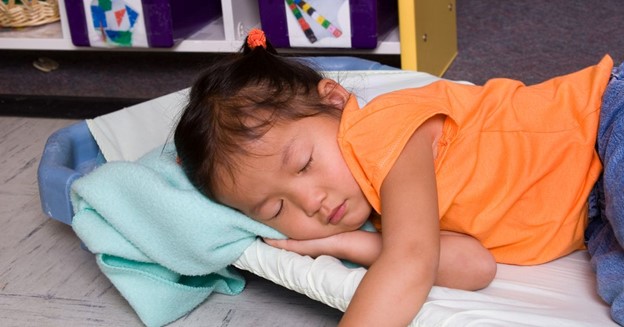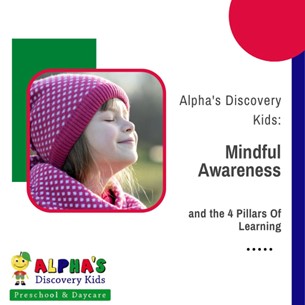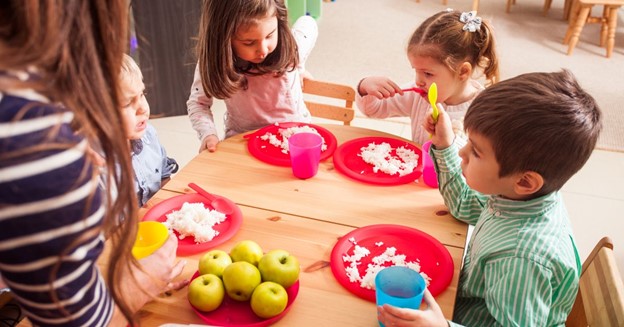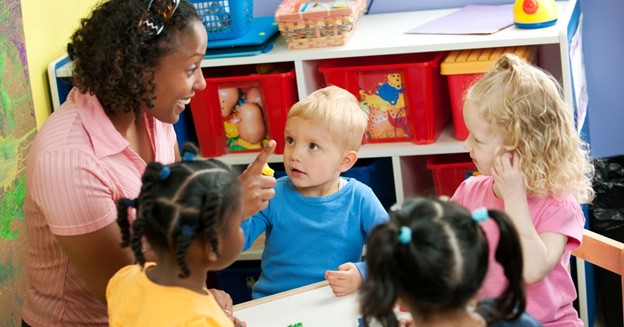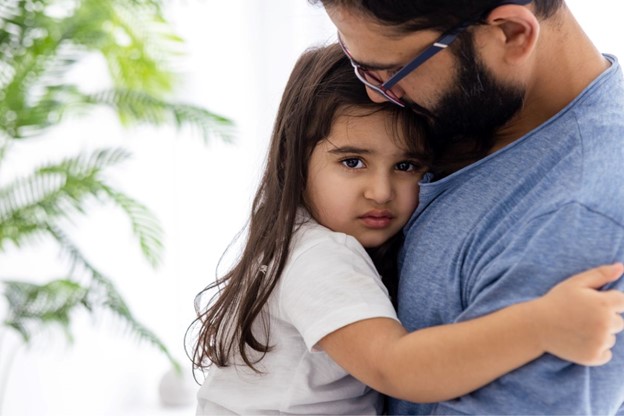Navigating Naptime: A Guide to Transitioning Naps for Growing Kids
Navigating Naptime: A Guide to Transitioning Naps for Growing Kids
by Susie Beghin, RECE, Founder of Alpha’s Discovery Kids
In the world of parenting and nurturing young minds, few subjects are as frequently discussed as sleep. Sleep isn’t just a routine part of life; it’s a cornerstone of a child’s well-being, influencing their physical health, emotional stability, cognitive development, and future success. As both a mother and an early childhood educator, I’ve seen firsthand the critical role that sleep plays in a child’s life. It’s not just a matter of rest; it’s a fundamental building block for their growth and happiness.
At Alpha’s Discovery Kids, we understand that there is no universal approach when it comes to sleep. Just as each child’s personality is unique, so are their sleep patterns. One of the common sleep-related issues we encounter in our daycare setting is the transition away from napping. As children mature, their needs and rhythms evolve, particularly when it comes to daytime naps. We recognize that naps are a vital component of early childhood, supporting their development and well-being. However, we’re also acutely aware that as children grow older, some may require shorter naps or even forego them altogether. This journey isn’t a one-size-fits-all experience; it’s a uniquely personal adventure for every child.
Phase Out Naps by Age: A Child-Led Approach
While there are general guidelines, it’s essential to remember that the transition from naps is a child-led process. As you can see from the chart below, sleep guidelines can vary with each age group, especially when it comes to children under 12 years old. At Alpha’s Discovery Kids, we understand the importance of an individualized approach to naps and sleep. Typically, as children grow and reach the age of around three years old, they may naturally begin to phase out naps. Signs that your child may be ready to move beyond regular napping include having shorter naps during the day, experiencing difficulty falling asleep for naps, or staying up very late in the evenings. Our educators observe these signs and adapt accordingly, ensuring your child gets the rest they need without pushing them into a set pattern.
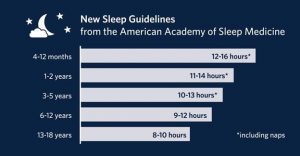
Consistency Between Home and Daycare
For parents of young children who attend daycare, achieving consistency in nap schedules is a crucial goal. It’s important for parents and caregivers to familiarize themselves with the daycare’s nap routines. This way, they can begin to coordinate their child’s nap schedule with the one followed at daycare. For instance, if your child is in the process of transitioning to a single, longer nap in the afternoon, the key is to gradually shift their naptime to synchronize with the daycare’s routine. This gradual adjustment, typically 15 minutes per day or every few days, ensures children’s comfort and a smoother adaptation to the new schedule. This synchronization not only facilitates a seamless transition but also helps parents maintain sleep consistency during weekends and breaks.
Why Slowly Phasing Out Naps Matters
Transitioning from naps can be a sensitive process, and going slowly is crucial as rushing this transition can lead to an overtired (and cranky) child. The goal is to allow children to ease into their new nap schedule. This slow transition is vital because abruptly stopping naps can be overwhelming for a child. As parents and educators, we want to provide the child with a comfortable and gentle shift to ensure their well-being.

Cute little kid girl hugging teddy bear sleeping lay in cozy bed, happy small child embracing toy fall asleep on soft pillow white sheets covered with blanket having healthy night sleep, top view
Child-Led Napping at Alpha’s Discovery Kids
Our child-led approach involves closely observing your child’s nap patterns. If your child still benefits from naps, we will continue to provide them as needed, even up to four years old, and sometimes beyond. Some children, at three or four years of age, may still require a nap, while others might not. We let your child’s needs guide us, and if it’s evident that naps are necessary for your child’s health and well-being, we support them in this. It’s important to remember that there is no one-size-fits-all answer when it comes to napping. While most children may transition away from naps around three years old, some may continue to benefit from them for a more extended period.
The transition from naps is a significant milestone in a child’s development, and it’s essential to approach it with sensitivity and flexibility. At Alpha’s Discovery Kids, we aim to provide the right balance, ensuring your child is well-rested while allowing them to adjust to their individual needs. This approach allows for a more relaxed transition, whether your child requires a nap or not, while in our care.
By closely observing your child’s sleep patterns, synchronizing nap schedules, and respecting their unique needs, we ensure that nap time transitions are smooth and beneficial for both children and parents. Naps are an essential part of a child’s routine, and whether your child is ready to transition to a full day of wakefulness or still requires daytime rest, we are here to provide the support and flexibility they need.
For more information on early childhood topics, check out my YouTube channel.
Holiday Gift Ideas for Toddlers and Preschoolers
Holiday Gift Ideas for Toddlers and Preschoolers
by Susie Beghin, RECE, Founder of Alpha’s Discovery Kids
As the holiday season approaches, parents of young children, especially those with infants and toddlers, may find themselves swept up in the whirlwind and stress of preparations, gift buying, and festivity planning. As a parent myself, I understand that we’re often tempted to rush through the holiday preparations – the shopping, the decorating, and the meal planning – and, in the process, we can sometimes forget the profound significance of being present. The act of slowing down and being fully engaged with our little ones is, perhaps, one of the most special gifts we can offer them.
At Alpha’s Discovery Kids, we’ve always emphasized the importance of presence, and understand the magic of a child’s first few years of life is irreplaceable. These are the years when their brains absorb knowledge like sponges, and their hearts open wide to the love and warmth of family. For parents of young children, it’s a chance to slow down, savor the little moments, and enjoy the glow in their children’s eyes as they discover the magic of the season.
With the constant demands of work and daily life, these special moments with our children are a gift beyond measure. Whether it’s a quiet evening by the fireplace, a snowball fight, or simply enjoying a warm cup of cocoa, focusing on the present moment and embracing the joy of togetherness creates lasting memories.
That said, for many families, the holidays are also a time for gift-giving. But it’s easy to get swept up in the latest toy trends and gadgets. Interestingly enough, it’s often not the flashiest or most expensive gift that young kids want; it’s something that engages their developing minds, encourages creativity, and fosters fun. Being mindful when buying gifts for our children can go a long way in ensuring they are gifts that keep on giving.
So, instead of scrambling to buy the latest fad, consider gifts that align with our 4 Pillars of Learning.
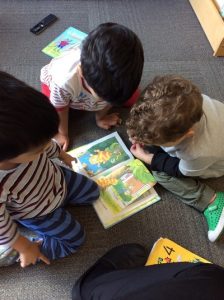
- Language & Literacy:
Beyond age-appropriate books, consider toys like sandpaper letters or magnetic letters that make learning the alphabet an engaging experience.
- Sandpaper Letters: These tactile tools help children connect letters with their shapes, enhancing early literacy skills.
- Magnetic Letters: Perfect for introducing young ones to the alphabet and word-building in an interactive way.
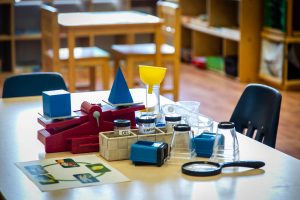
- STEAM (Science, Technology, Engineering, Art, and Math):
With a wide range of options, here are some ideas to explore:
- Science – Magnifying Glass: Spark your child’s curiosity with a tool that opens up the world of exploration.
- Technology – A Digital Microscope: An engaging combination of technology and science, allowing young minds to examine the world up close.
- Engineering – Building Blocks: Wooden building blocks are a classic toy that nurtures creativity and spatial skills.
- Arts – Art Supplies: From playdough to various types of paint and paintbrushes, these tools help children express themselves creatively.
- Math – Math Counters and Math Cubes: Fun manipulatives that make learning math concepts enjoyable.
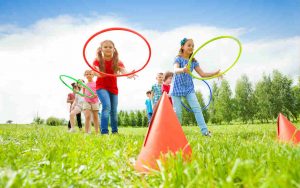
- Physical Activity & Nutrition:
Encouraging physical activity and promoting healthy nutrition for young children is not only vital for their well-being but also a wonderful gift in itself.
- Riding Toys – These encourage physical activity (whether a bike or a riding car)
- Pretend Play Food: Encourage imaginative play and teach young ones about nutrition with pretend food sets.

- Mindfulness:
You can never go wrong with gifts that encourage mindfulness.
- Be Kind Cubes: These cubes offer a fun way to teach children about kindness and empathy, important attributes that align with the pillar of mindful awareness.
- Sensory materials or tables: The materials encourage children to use their senses and evoke a sense of calm.
Remember, the best gifts for young children are those that nurture their development and foster their growth through the joy of learning through play.
Practicing mindfulness during this season is a gift we offer both to ourselves and our little ones. So, let’s take it slow, savor every moment of this season, and treasure the magic of the present with our children.
For more information on early childhood education topics, check out my YouTube videos or to book a tour, please contact us.
Fostering Mindful Awareness in the Early Years
Fostering Mindful Awareness in the Early Years
by Susie Beghin, RECE, Founder of Alpha’s Discovery Kids
As I wrote my book, ‘Learn To Play’, my primary mission always centered around one core principle: providing children with the most exceptional start in life. And in my role as a mother and Early Childhood Educator, I have an unwavering commitment to help our children develop the critical skills essential to their lifelong success.
Parents and caregivers hold a unique position as the primary educators in a child’s life. At Alpha’s Discovery Kids, we’ve made it our goal to complement and enhance the invaluable work you’re already doing at home. We achieve this by expertly guiding children through our Four Pillars of Learning, ensuring that their learning experiences are not just educational but deeply meaningful.
Each pillar contributes to a well-rounded and holistic educational experience. Our pillars consist of Language & Literacy, STEAM (Science, Technology, Engineering, Art, and Math), Physical Activity & Nutrition, and Mindful Awareness,
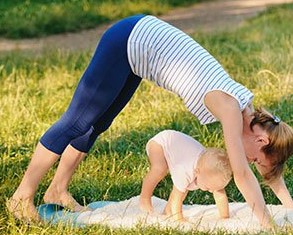
Mindful Awareness
Mindfulness, at its core, is like a gentle embrace of the present moment, both inside and out. It’s about purposefully tuning into what’s happening right now without any judgment or the weight of desiring things to be different.
Mindfulness isn’t just a tool for grown-ups seeking to reduce stress, boost their well-being, and find their way back to calm amidst life’s storms. Its soothing benefits extend to the world of children, where worries and mental health concerns are increasingly common. By introducing mindfulness practices to children, we can offer them the same mental health gifts that adults enjoy. And, as an added bonus, it helps to nurture deeper connections between adults and kids, fostering open communication, empathy, and unwavering emotional support.
One of the most profound gifts that mindfulness imparts to children is the development of self-regulation skills. They learn how to navigate challenging situations, maintain composure, and return to a state of tranquility even in the midst of turmoil. These skills are instrumental in managing emotions, staying focused, paying attention, and blocking out distractions.
It’s quite fascinating when you watch babies and little kids. You’ll see something remarkable: they’re really good at being in the here and now. Children (usually under 4 years old) are experts at this. They don’t worry about what happened before, and they don’t fuss about what’s coming next. They simply live in the moment without making things too complicated. But as they get older, this natural skill often fades away. That’s where we, as parents and teachers, come in. Our job is to help them hold onto this wonderful ability.
The journey begins with us – the adults. We cannot effectively teach mindfulness if we are not willing to embrace it ourselves. To nurture mindfulness in our children, we first become mindful parents and educators. This means immersing ourselves in the practice and reaping the benefits it offers. Try being fully present with your child, as this helps them feel acknowledged and valued, nurturing their overall development. Active listening goes beyond just hearing words; it involves understanding the emotions, needs, and feelings behind what they say. Children often express themselves through their emotions, not just their words.
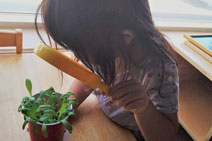
At Alpha’s Discovery Kids, mindful awareness permeates every aspect of our curriculum. We believe that mindfulness is not just an activity; it’s a way of life. It’s a way of being with children, nurturing their growth and well-being.
In our classrooms, mindfulness activities take various forms, providing children with tools to develop and sustain mindfulness throughout their lives. Here are some ways we incorporate mindfulness activities:
- The use of “calming jars” filled with sparkling glitter. By simply shaking and observing the falling sparkles, children engage their senses and return to the present moment.
- Deep breathing exercises, combined with gentle movements. These instill calmness in both body and mind.
- Activities such as the “5 Senses Exercise“, which encourage children to list things they see, touch, hear, smell, and taste, grounding them in the present moment.
- Provide lots of outdoor activity. Surrounded by the serenity of nature, children naturally feel a sense of calm. Nature walks, bird-watching, and cloud-gazing are just a few ways we integrate mindfulness into our outdoor experiences.
At Alpha’s Discovery Kids, mindfulness isn’t just a concept; it’s a philosophy. We understand that the early years of a child’s life are the most pivotal, and our commitment to their holistic development extends to nurturing their mindfulness. As we guide children to notice and appreciate each moment, both inside and out, we’re sowing the seeds for a lifetime of well-being, resilience, and happiness. Each child under our care is cherished as an extension of our own families, and their health and happiness remain our paramount focus.
For more information about early childhood education topics, check out my YouTube series.
To book a tour of one of our centres, please contact us .
Navigating Cold and Flu Season
Navigating Cold and Flu Season
by Susie Beghin, RECE, Founder of Alpha’s Discovery Kids
As parents, we all want our little ones to stay healthy and happy. However, it’s no secret that young children can be particularly susceptible to colds and the flu. If your child attends daycare, you may have noticed that illnesses seem to make their rounds quite frequently, particularly for those in the 12-18 month age group. This may raise concerns among parents, but it’s essential to understand the underlying cause.
Here at Alpha’s Discovery Kids, we provide an environment where children come together to learn, play, and interact. While these interactions are incredibly valuable for their social and emotional development, they also mean that children are exposed to more germs and viruses than they would be at home.
But believe it or not, this early exposure to various illnesses can be beneficial in the long run. Our immune systems learn by doing. When children are exposed to viruses, their immune systems learn to recognize and fight them off. This exposure helps build their immunity, making them less susceptible to similar illnesses in the future.
Although no parent wants to see their child sick, young children often bounce back from illnesses more quickly than adults. Their bodies are primed to recover swiftly, which means that while they may experience more illnesses, these illnesses tend to be milder and shorter in duration. It’s all part of the learning process their immune systems go through.
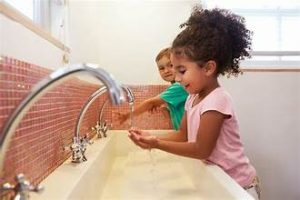
Cold and Flu Prevention
That said, as we approach cold and flu season, there are some things we do at each of our locations to help prevent the spread of illness. One of the most effective ways to minimize the spread of illnesses is through proper hygiene. Hand washing is a crucial practice that we encourage among both children and staff. Our daycare facilities are equipped with sanitation stations, and our dedicated team ensures that children wash their hands frequently throughout the day.
Nutrition also plays a significant role in building a robust immune system. We believe that nutrition plays such a large role in our children’s development that nutrition (and physical activity) is one of our 4 Pillars of Learning, in addition to Language & Literacy, STEAM (Science, Technology, Engineering, Art and Math), and Mindful Awareness. We focus on providing balanced meals and snacks that support your child’s health and well-being, as a well-nourished body is better equipped to fight off infections.
In addition, we maintain open lines of communication with parents. If your child isn’t feeling well, we need to know. By keeping sick children at home, we can help prevent the spread of illnesses within our daycare community.
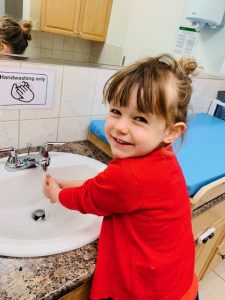
Preparing for Cold and Flu Season
As a parent, there are several steps you can take to prepare for cold and flu season and help keep your child healthy:
- Teach Good Hygiene: Encourage your child to wash their hands regularly with soap and water for at least 20 seconds. Teach them to cover their mouth and nose when sneezing or coughing, ideally with a tissue or their elbow.
- Maintain a Healthy Diet: Provide your child with a balanced diet rich in fruits, vegetables, and whole grains to support their immune system.
- Get Plenty of Rest: Ensure your child gets enough sleep as it plays a vital role in immune system function.
- Consider Probiotics: Some studies suggest that probiotics may help boost the immune system. Consult with your pediatrician or family doctor before adding any supplements to your child’s diet.
- Stay Informed: Keep yourself informed about current health guidelines and recommendations, especially during cold and flu season.
- Get Some Vitamin C and D – Whether it is by natural method (sun/oranges) or supplements, it’s important to get these vitamins.
While it’s common for children to experience more illnesses in daycare settings, it’s part of their natural immune system development. Alpha’s Discovery Kids is committed to creating a supportive and healthy environment for your child, and we encourage parents to partner with us in supporting wellness initiatives. By teaching good hygiene practices, maintaining a healthy lifestyle, and staying informed, you can help your child stay resilient and thrive, even during cold and flu season.
For more information about topics related to the early years, check out my YouTube videos at or to book a tour, please contact us at https://www.alphasdiscoveryclub.com/contact/ .
Cultivating Healthy Bodies and Minds: The Importance of Physical Activity & Nutrition for Children
Cultivating Healthy Bodies and Minds: The Importance of Physical Activity & Nutrition for Children
by Susie Beghin, RECE, Founder of Alpha’s Discovery Kids
As an Early Childhood Educator and a mother, my life’s mission has always been clear: to provide children with the best possible start in life. I deeply understand the significance of nurturing every facet of a child’s development. This unwavering commitment led me to create a comprehensive educational framework known as the Four Pillars of Learning.
The Four Pillars of Learning, prominently displayed in every classroom across our three Alpha’s Discovery Kids locations, ensure that children have access to a well-rounded education. These pillars address a child’s physical, cognitive, social, emotional, and spiritual well-being and comprise Language & Literacy, STEAM (Science, Technology, Engineering, Art, and Math), Physical Activity & Nutrition, and Mindful Awareness.
In today’s world, where childhood obesity is on the rise, it’s crucial that we take a proactive approach to children’s health. This proactive approach begins with education, instilling the importance of physical activity and nutrition right from birth.

Physical Activity: Building Strong Bodies and Minds
Physical activity isn’t just about keeping the body in motion; it’s about nurturing the mind and promoting emotional well-being. The benefits of physical activity extend beyond the physical; they encompass mental and emotional health as well. Engaging in physical activities can improve bodily functions, elevate mood, and promote the healthy development of bones and muscles.
At Alpha’s Discovery Kids, we recognize the importance of physical activity in the early years. We firmly believe that building a foundation for physical well-being early in life can positively impact a child’s entire existence.
In early childhood, children are naturally active, curious, and fearless. They have a genuine willingness to explore and discover their own abilities. This is a crucial time for them to have opportunities to climb, run, crawl, dance, jump, balance, and engage in a multitude of activities. These activities not only build physical strength but also foster self-confidence, coordination, and concentration right from an early age.
In our daycare setting, we wholeheartedly embrace the significance of physical activity, both indoors and outdoors. We understand that children need a variety of movements to support their growth and development. Whether it’s gross motor skills, involving larger muscles and movements, or fine motor skills, which focus on smaller muscle groups like fingers learning to grip a pencil, we ensure that both are a part of the daily routine.
For gross motor skills, we often engage in activities like engineering with building blocks or encouraging kids to run and play outside. Fine motor skills are honed through activities such as threading beads or playing with playdough. This comprehensive approach ensures that children are developing both their larger muscle groups and their fine motor control.

Nutrition: Fueling Healthy Lives
In tandem with physical activity, proper nutrition plays a pivotal role in a child’s development. At Alpha’s Discovery Kids, we embrace family-style dining, where children sit together at a table with a teacher, and are encouraged to be independent. This approach brings several benefits. It empowers children to portion their meals themselves, fostering a sense of self-regulation and helping in the battle against childhood obesity.
Furthermore, family-style dining exposes children to a balanced menu with foods from all food groups, ensuring they receive the essential vitamins and minerals they need. Variety is at the core of our nutritional philosophy. We encourage children to explore various foods from diverse cultures, expanding their palates and discovering different flavors, textures, and tastes. Our emphasis is on whole foods with minimal processing, a fundamental principle in our approach to nutrition.
Setting a positive example is of utmost importance. Children often emulate the eating habits of adults, so we, as caregivers, should strive to be good role models. We should not only focus on what we eat but also how we eat and when we eat. Involving children in meal preparation, from setting the table to selecting fruits and vegetables during grocery shopping, gives them a sense of involvement and helps them understand where their food comes from.
In addition, teaching children to recognize proper portion sizes will help guide them on how to satisfy their hunger without overeating or undereating. This sets the stage for a healthy relationship with food that can last a lifetime.
The Physical Activity & Nutrition pillar at Alpha’s Discovery Kids is not merely a program; it’s a way of life. We are passionate about nurturing children’s physical well-being through a combination of active play and nutritious eating. We firmly believe that by instilling these healthy habits from a young age, we are laying the foundation for a lifetime of well-being and success. Every child in our care is treated as an extended part of our own families, and their health and happiness are our top priorities.
For more information, or to book a tour, please contact us!
The Importance of Socialization for Young Children: Nurturing Minds and Hearts
The Importance of Socialization for Young Children: Nurturing Minds and Hearts
by Susie Beghin, RECE, Founder of Alpha’s Discovery Kids
At Alpha’s Discovery Kids, we are passionate about providing children with an environment where they can learn, grow, and thrive. And we deeply understand the paramount importance of socialization in a child’s early years. It’s not merely about play; it’s a foundational element of a child’s development that shapes their future in profound ways. We recognize that children are inherently social beings, wired to connect, learn, and grow through interaction with their peers and caregivers.
As a parent myself, I understand how crucial socialization is to nurturing empathy, honing communication skills and learning the art of human interaction. In the ever-evolving landscape of early childhood education, we understand that the first six years of a child’s life are the most formative. It’s during this period that a child’s brain is in a state of rapid development, absorbing knowledge, experiences, and social cues like a sponge. As Early Childhood Educators, we are not merely caretakers; we are shapers of young minds and hearts.
To us, socialization is not a byproduct of our curriculum but an integral part of it. Alpha’s Discovery Kids understands that every child is unique, and their social needs vary. Some children may thrive in a bustling social environment, while others may need more gradual and individualized socialization experiences. Our approach is flexible, recognizing and respecting these differences, allowing each child to bloom at their own pace.

The effects of COVID-19 on socialization
The COVID-19 pandemic presented unprecedented challenges for children’s socialization. Social distancing measures, mask mandates, and lockdowns disrupted the traditional avenues for social interaction. Many children missed out on the crucial social experiences that daycare and preschool settings offer. Here are some of the effects we observed during this challenging period:
- Insecure Attachment Issues: When young children are unable to establish secure attachments due to limited social interaction, it can have devastating consequences for their emotional well-being. Secure attachments form the basis of healthy relationships later in life.
- Excessive Crying: Inconsolable crying can be a sign of distress caused by a lack of socialization. Children need the comforting presence of caregivers and peers to feel safe and secure.
- Language Delays: Language development relies heavily on social interaction. With masks obscuring our facial expressions and limiting verbal communication, we noticed that language delays became more prevalent among young children.
The Importance of Early Socialization
The longer children are isolated from social experiences, the harder it can be to reintegrate them into social settings like daycare. A 3-year-old who has been isolated for an extended period may face more significant challenges than a 12-month-old in adjusting to group environments. Early socialization sets the stage for a child’s future interactions and relationships, making it a critical aspect of their development.
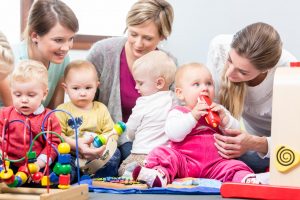
Three dedicated and happy young mothers sitting together on the floor, while watching their babies playing with safe multicolored toys at a modern playground for infants
Alpha’s Discovery Kids has observed significant advantages associated with socialization, and these benefits extend beyond full-time care. Even part-time attendance provides numerous advantages. Here are some of the benefits of socializing at daycare:
- Emotional Development: Children learn to identify and manage their emotions through interactions with peers and caregivers. They develop empathy, conflict resolution skills, and a sense of belonging.
- Cognitive Growth: Social play fosters cognitive development. Children engage in problem-solving, creativity, and critical thinking as they interact with others.
- Language Skills: Daily interactions with peers and teachers help improve language skills. Children learn to communicate effectively, expanding their vocabulary and language fluency.
- Independence: Socialization encourages independence. Children learn to make choices, solve problems, and take initiative in a supportive environment.
At Alpha’s Discovery Kids, every child in our care is treated as an extended part of our own families. We provide a nurturing and stimulating environment where socialization is a central focus. Our dedicated teachers, who are always patient, caring, and committed to making each child’s experience the best it can be, facilitate social interactions that promote growth and development.
We believe that socialization is not a luxury but a necessity for young children’s development. The pandemic underscored its significance, reminding us that socialization is vital for emotional, cognitive, and social growth. At Alpha’s Discovery Kids, we remain dedicated to providing a safe and enriching environment where children can thrive through socialization, guided by our Four Pillars of Learning. We are committed to empowering the leaders and innovators of tomorrow, one social interaction at a time.
For more information about how to use the Four Pillars of Learning system, check out Susie’s book, Learn To Play: The Four Pillars Learning System on Amazon.
For more information on early childhood topics, check out my YouTube series, or to book a tour, please contact us.
Unlocking the Wonders of STEAM: Embracing the Power of Math
Unlocking the Wonders of STEAM: Embracing the Power of Math
by Susie Beghin, RECE, Founder of Alpha’s Discovery Kids
At Alpha’s Discovery Kids, we are passionate about providing a nurturing and enriching learning environment where children can thrive.
As advocates of STEAM education, we wholeheartedly embrace the power of Science, Technology, Engineering, Arts, and Math in shaping well-rounded individuals. Our commitment to excellence lies in infusing STEAM concepts throughout our curriculum, empowering young minds with essential skills and fostering a love for learning that lasts a lifetime.
And that’s why we created our unique and comprehensive approach to education, centered around the “The Four Pillars of Learning.” These pillars serve as the foundation of our curriculum, ensuring that every child’s physical, cognitive, social, emotional, and spiritual well-being is nurtured and supported.
The 4 Pillars of Learning consist of Language & Literacy, STEAM (Science, Technology, Engineering, Arts, and Math), Physical Activity & Nutrition, and Mindful Awareness. Each pillar is carefully designed to complement and reinforce one another, creating a holistic learning experience that fosters creativity, critical thinking, and a growth mindset in our young learners.
By embracing these four pillars, we aim to provide a well-rounded education that prepares children not only for academic success but also for personal growth and success in all aspects.
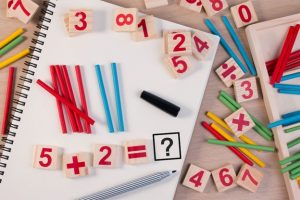
When it comes to Math, it is more than just numbers and equations. Math is a fundamental tool for understanding the world around us. From counting and measuring to problem-solving and critical thinking, math plays an integral role in shaping a child’s cognitive abilities and analytical skills.
Math is an important part of a child’s development from ages 1 to 5 years. During this time, children explore patterns, shapes, sizes, and counting and encounter math concepts in their everyday activities, from counting cars on the road to the number of plates on the table.
However, math can be daunting for both kids and parents. That’s why we believe in teaching math in a visual and hands-on way. For example, when we say 1 plus 1 equals 2, it’s easier to understand when we can see and touch objects to represent those numbers. We want children to experience math in a concrete way, so they truly grasp its concepts.
Math is all around us, and it’s essential to make it approachable and enjoyable for everyone. Some important math skills that we focus on here at Alpha’s Discover Kids include:
Numeracy skills – Skills like counting are among the first things children learn. Many children learn to count from 1 to 10 by age three. We encourage counting everyday objects in a hands-on way to help them grasp the concept. Once children start to understand the concept of counting, you can introduce written numbers so they learn to associate the written form with the concept.
Problem-solving – Another essential math skill is problem-solving, although this can be a tricky concept for many kids. We support children in their problem-solving process without doing it for them. By using number concepts and skills, we help them develop confidence in their own ability to think things through.
Measurement – Measurement is an exciting aspect of math. Children can explore time, weight, distance, length, height, and width in various activities.
Classification – Classification is a fun game where children sort and classify objects based on different characteristics like shape, size, or colour.
To incorporate math into everyday activities, we sort various items into baskets, provide objects to count while filling and emptying containers, and make number figures from play dough. These activities make math a part of their daily fun, helping children build essential math skills while having a great time.
We aim to instill a love for Math by making it accessible, enjoyable, and applicable to the real world. We foster a growth mindset, where children embrace challenges, ask questions, and take risks in their mathematical explorations.
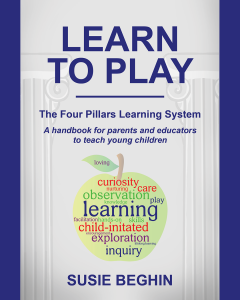
For more information about how to use the Four Pillars of Learning system, check out Susie’s book, Learn To Play: The Four Pillars Learning System on Amazon.
For more information about Alpha’s Discovery Kids, or to book a tour, please contact us at https://www.alphasdiscoveryclub.com/contact/ or call us at 905-823-8257.
Understanding Separation Anxiety: Navigating Emotions and Building Resilience
Understanding Separation Anxiety: Navigating Emotions and Building Resilience
by Susie Beghin, RECE, Founder of Alpha’s Discovery Kids
As a mother of 2 children and owner of Alpha’s Discovery Kids, I am all too familiar with separation anxiety.
Separation anxiety is a normal part of a child’s development, marked by distress when they are separated from their primary caregiver or a familiar environment. During this phase (which usually peaks between 8-18 months), children may become clingy, cry, or show signs of distress when a parent or caregiver leaves their sight.
Although this stage can be especially trying for parents, separation anxiety is actually a sign of a strong bond between the child and their caregiver. It’s also normal for us parents to experience a bit of separation anxiety when we have to leave our child!
At Alpha’s Discovery Kids, we understand the challenges that come with separation anxiety, both for children and parents. Our experienced and caring team is here to provide the support and guidance needed to ease the transition during this phase.
Understanding separation anxiety is the first step towards easing the stress that often comes with this stage of a child’s development.

Communication is Key
Communication is key during this phase. Explaining to our children what will happen while we are apart and when we will return helps them understand that separations are temporary. Showing confidence and trust when leaving them with other caregivers or in new environments comforts our little ones, reinforcing that they are safe and loved.
Empathy and validation of their emotions are vital. Letting them know it’s okay to feel sad or scared when apart and offering words of comfort, reassurance, and understanding assures them that it’s natural to miss someone they love. We are always there for them, no matter the distance.
Establish a consistent routine
As parents, we want to provide the best support for our little ones as they navigate their emotions during separations.
One way to ease separation anxiety is by having a routine. A consistent and predictable routine helps children feel secure and prepared for upcoming separations. By providing comfort and reassurance before leaving and upon returning, your child will have a sense of safety, stability, and reassurance that we will always return.
As you drop off your child at daycare, we encourage parents to let the teachers do what they are trained to do. As difficult as it is to leave, I know from experience that most often, within 10-15 minutes of parents walking out the door, their child will calm down and be distracted by their peers, toys or activities going on in the classroom.
Stay Calm and Patient (and set a positive tone)
Separation anxiety can be challenging for both children and parents. But parents need to understand they are the ones who set the tone. You want this to be a positive experience which means you, as the parent, need to approach separating in a positive way. If you have any negative feelings or apprehensions, your child will pick up on this.
Staying calm and patient during moments of distress is essential for both children and parents. Remember, this phase is a normal part of their development, and will pass with time.
Encouraging their independence in exploring their environment and trying new things builds their confidence, making separations less anxious. And by fostering interactions with other trusted adults and children in safe and enjoyable settings, you can allow these connections to help your child feel secure in various environments.
Provide a familiar item
Building a safe and welcoming environment is another essential aspect. Surrounding our children with familiar objects, toys, or comfort items offers them a sense of security even when they are away from us. Sending your child with a keepsake item that reminds them of you and being at home will make the separation much easier. This item could be a photo, favourite toy or stuffed animal.
Gradual Goodbyes
When it’s time to say goodbye, keep it brief and positive. Prolonged goodbyes can make the separation more challenging for both you and your child. Reassure them that you will be back soon and give them a loving hug or kiss before leaving.
Consistency is essential in helping children feel secure during separations. Try to maintain a regular schedule and routine as much as possible. Consistency can give children a sense of predictability and stability, reducing anxiety.
Seek Support if Needed
Remember, separation anxiety is a natural part of growing up, and with patience, understanding, and support, children can navigate this phase successfully. By offering comfort, reassurance, and gentle transitions, we can help our children develop resilience and emotional security, setting the stage for confident and independent individuals in the future.
Watch our YouTube video for more strategies and support during this difficult time.
At Alpha’s Discovery Kids, we strive to make the transition during separation anxiety as smooth as possible for both children and parents. Through a nurturing environment, consistent routines, and supportive educators, we help children feel secure and confident while their parents are away.
Our focus on building positive relationships, encouraging independence, and offering open communication creates a caring community where children can thrive and grow. With our dedicated team by their side, children can navigate separation anxiety with resilience and emotional well-being, setting the foundation for a positive and fulfilling early childhood experience.
For more information on our 4 Pillars of Learning, or to book a tour, please contact us at https://www.alphasdiscoveryclub.com/contact/ or call us at 905-823-8257.
Unlocking Creativity and Expression: The Essential Role of Art in STEAM Education
Unlocking Creativity and Expression: The Essential Role of Art in STEAM Education
by Susie Beghin, RECE, Founder of Alpha’s Discovery Kids
“Art is about letting go” – Susie Beghin
At Alpha’s Discovery Kids, our mission is to create a nurturing and safe space where every child feels at home. We understand the significance of holistic education, especially during the formative years of early childhood. As young minds develop rapidly, we recognize the importance of providing the best learning environment to support their growth and development.
Childhood is a time of exploration, curiosity, and boundless creativity. That’s why we believe in child-initiated and teacher-supported learning experiences that encourage children to be active participants in their education. Our commitment to fostering a love of learning led us to develop the Four Pillars of Learning: Language & Literacy, STEAM (Science, Technology, Engineering, Art, and Math), Physical Activity & Nutrition, and Mindful Awareness.
While traditional STEM education focuses on Science, Technology, Engineering, and Math, we believe that incorporating the Arts (A) into the equation is vital. The Arts, in the context of STEAM, play a transformative role in nurturing creativity, critical thinking, and problem-solving skills in children.
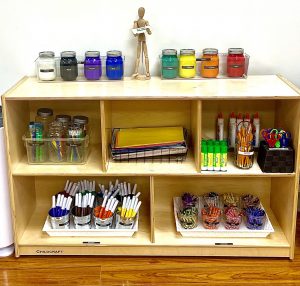
Art is often misunderstood or underappreciated as a vital component of learning. Some may view art as an extra-curricular activity or mere creative play, not realizing its significant contributions to a child’s development. However, we firmly believe that art is not just about drawing or painting; it is about the creative process and fostering imagination.
For instance, art and creativity are fundamental to engineering. Engineers need to think outside the box, innovate, and find solutions to complex problems. Art allows children to think creatively, develop original ideas, and view challenges from various perspectives, which are essential skills for future engineers.
Art is also a process-oriented activity rather than a product-oriented one. It encourages children to explore their imagination, experiment with different materials, and express themselves freely. The act of creating art builds fine motor skills as children learn to hold crayons and paintbrushes. Through art, they learn to communicate their thoughts and emotions, developing their language and self-expression abilities.
At Alpha’s Discovery Kids, we emphasize the importance of providing opportunities for children to engage in art freely. There should be no pressure to create a specific end product; instead, we focus on allowing children to explore and experiment with materials independently. Art is about letting go, embracing creativity, and embracing the joy of the process itself.
There are countless art ideas that children can explore, from painting and drawing to molding and collage-making. We provide various materials, such as markers, child-safe scissors, paint, glue, feathers, and pompoms, to ignite children’s imagination and creativity. By providing open-ended materials, we empower children to choose how they want to participate and let their creativity flow.
We also integrate art with other STEAM components to create a multidimensional learning experience. For instance, while making an animal out of clay (art), we can build the animal’s home (engineering), learn about its characteristics (science), find pictures of the animal on the computer (technology), and measure its size (math). This interdisciplinary approach enhances children’s understanding and application of knowledge. You can find out more about how to incorporate art into STEAM in Susie’s book, Learn To Play.
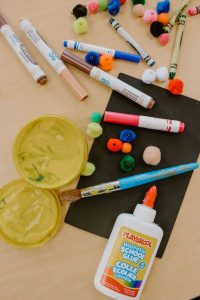
Art is not just crafts; it goes beyond following instructions and specific outcomes. We emphasize the process of making art, encouraging children to explore different materials and techniques. For instance, instead of merely painting on paper, we might encourage children to paint with a straw on a cardboard box, adding multiple dimensions to the experience.
Incorporating the Arts into STEAM education allows us to nurture creativity, self-expression, and problem-solving skills in children. It sets the stage for future innovation and exploration, fostering a love of learning that lasts a lifetime. At Alpha’s Discovery Kids, we celebrate art as a vital aspect of our holistic approach to education, empowering children to become confident, creative, and compassionate individuals.
For more information on our Four Pillars of Learning, or to book a tour, please contact us at https://www.alphasdiscoveryclub.com/contact/ or call us at 905-823-8257.
Announcing my new YouTube Channel
Announcing my new YouTube Channel – @Susie-Alphas
by Susie Beghin, RECE, Founder of Alpha’s Discovery Kids
As an educator and a mother of two wonderful kids, I understand the challenges and joys of parenting firsthand. Over the years, I have encountered numerous questions from parents seeking guidance on a wide range of topics related to early childhood. Whether it’s dealing with a toddler’s constant “no,” managing separation anxiety or finding the right daycare, I have heard it all.
And my experience ultimately led me to write my book, ‘Learn To Play,’ where I used the knowledge I have gained as an ECE educator and mother to create our unique curriculum, The Four Pillars of Learning. My goal is to share this teaching method with parents and educators as a tool for learning at home and in the child care setting.
And now, I am adding a new way of sharing information with parents. I am thrilled to announce the launch of my new YouTube channel, @Susie-Alphas. I created this platform to address your burning questions and concerns about early childhood and to provide a go-to resource for reliable information. My hope for this endeavor is to help parents navigate the early years, and that’s precisely what I aim to do with this channel.
The information on early childhood is scattered across the internet, making it challenging for parents to find comprehensive and reliable answers to their specific questions. In launching this YouTube channel, I aim to create a focal point where parents can turn to for valuable insights and practical advice on various aspects of early childhood.
One of the driving forces behind @Susie-Alphas is to provide real answers to real questions from real parents. I encourage you to send in your questions, and each week, I will address a new question in a video. Your questions are what make this channel truly valuable, as they reflect the concerns and interests of parents just like you. If a question or concern arises frequently, you can expect a video on that topic because if it’s essential to you, it’s essential to me as well.
As you explore the @Susie-Alphas YouTube channel, you’ll also find links to my book, ‘Learn To Play,‘ which serves as a comprehensive guide for parents and caregivers. It delves deeper into various aspects of early childhood, providing you with more in-depth knowledge and understanding.
My aim is to inform, support, and empower parents on their journey through the early years. Some of the topics I plan to cover include mom guilt, building confidence in your child’s environment, managing toddler behaviour, handling separation anxiety, finding the right daycare, addressing biting behaviour, navigating potty training and nutrition.
However, the journey doesn’t end here. I want to hear from you! What else do you want to know about early childhood? Let me know your burning questions, and I’ll make sure to address them in upcoming videos.
I firmly believe that the @Susie-Alphas YouTube channel will allow parents to come together in this virtual space, creating a supportive community where we share similar experiences, challenges, and triumphs.
Don’t forget to subscribe to @Susie-Alphas on YouTube and hit the notification bell so you never miss a video. Together, let’s navigate the early years and create a strong and supportive community of parents who are ready to embrace the joys and challenges of parenting.
For more information on our 4 Pillars of Learning, or to book a tour, please contact us at https://www.alphasdiscoveryclub.com/contact/ or call us at 905-823-8257.

